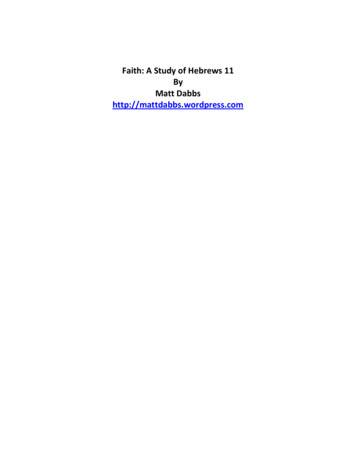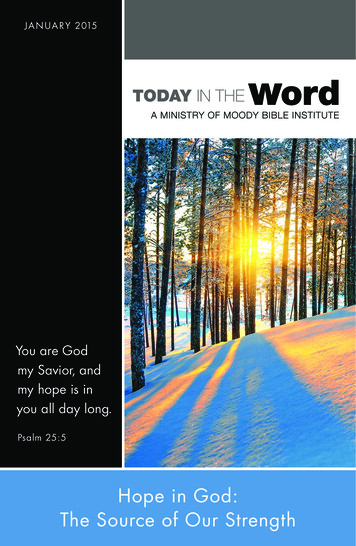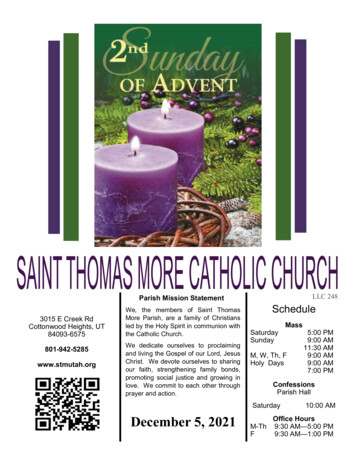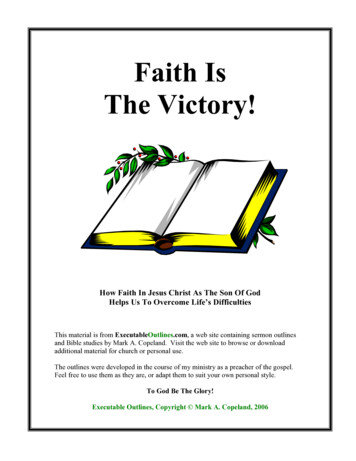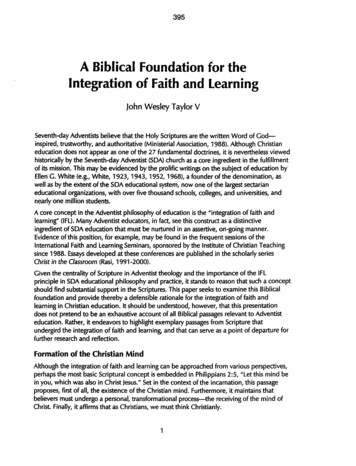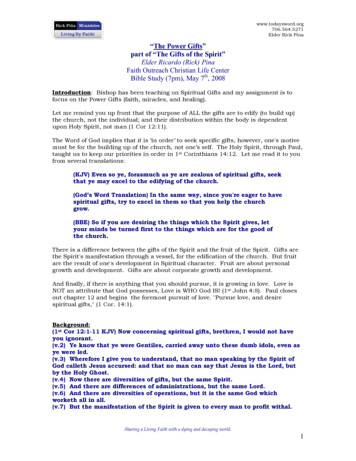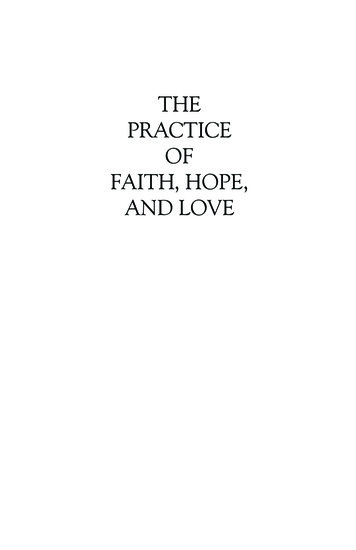
Transcription
THEPRACTICEOFFAITH, HOPE,AND LOVE
This series offers fresh translations of key writings from the seventeenth and eighteenth centuries, making them accessible to thetwenty-first century church. These writings from the “Further Reformation” in the Netherlands offer a balance of doctrine and piety,a mingling of theology and life that has seldom been equaled in thehistory of Christianity. Each book in this series will provide invaluable insight into a vibrant part of the Christian heritage.Other Books in the Series:Jean Taffin, The Marks of God’s ChildrenJacobus Koelman, The Duties of ParentsGisbertus Voetius and Johannes Hoornbeeck,Spiritual DesertionWillem Teellinck, The Path of True GodlinessWilliam Schortinghuis, Essential Truths in theHeart of a ChristianJodocus van Lodenstein, A Spiritual Appeal toChrist’s BrideGuilelmus Saldenus and Wilhelmus à Brakel,In Remembrance of Him: Profiting from the Lord’s Supper
THEPRACTICEOFFAITH, HOPE,AND LOVEGodefridus UdemansTranslated by Annemie GodbehereEdited by Joel R. BeekeREFORMATION HERITAGE BOOKSGrand Rapids, Michigan
The Practice of Faith, Hope, and Love 2012 by the Dutch Reformed Translation SocietyPublished byREFORMATION HERITAGE BOOKS2965 Leonard St. NEGrand Rapids, MI 49525616-977-0889 / Fax 616-285-3246e-mail: orders@heritagebooks.orgwebsite: www.heritagebooks.orgPrinted in the United States of America12 13 14 15 16 17/10 9 8 7 6 5 4 3 2 1All rights reserved. No part of this publication may be reproduced, stored ina retrieval system, or transmitted in any form or by any means—for example,electronic, photocopy, recording—without the prior written permission of thepublisher. The only exception is brief quotations in printed reviews.Library of Congress Cataloging-in-Publication DataUdemans, Godefridus, ca. 1580-1649.[Practycke. English]The practice of faith, hope, and love / Godefridus Udemans ; translated byAnnemie Godbehere ; edited by Joel R. Beeke.p. cm. — (Classics of Reformed spirituality)ISBN 978-1-60178-214-4 (pbk. : alk. paper) 1. Christian ethics. I.Godbehere, Annemie. II. Beeke, Joel R., 1952- III. Title.BJ1221.U413 2012241’.4—dc232012045363
ContentsSeries Preface viiIntroduction 1Part 1—The Chief Christian Virtues 191. A Description of the Chief Christian Virtuesand How to Distinguish Them 212. The Benefit and Necessity of These Virtues 293. The Practice of Faith, Hope, and Love 36Part 2—The Practice of Faith: The Apostles’ Creed 454. Articles of Faith 475. The First Article 506. The Second Article 577. The Third Article 648. The Fourth Article 699. The Fifth Article 7610. The Sixth Article 8011. The Seventh Article 8512. The Eighth Article 89
viThe Practice of Faith, Hope, and Love13. The Ninth Article 9314. The Tenth Article 10115. The Eleventh Article 10616. The Twelfth Article 111Part 3—The Practice of Hope: The Lord’s Prayer 11717. The Preface 11918. The First Petition 12619. The Second Petition 13120. The Third Petition 13721. The Fourth Petition 14222. The Fifth Petition 14823. The Sixth Petition 15524. The Conclusion 16125. Rules for Right Prayer 167Part 4—The Practice of Love: The Ten Commandments 19126. Rules and the Preface 19327. The First Commandment 20128. The Second Commandment 22529. The Third Commandment 25530. The Fourth Commandment 28131. The Fifth Commandment 30932. The Sixth Commandment 33333. The Seventh Commandment 35834. The Eighth Commandment 42235. The Ninth Commandment 45036. The Tenth Commandment 473Afterword 491Dutch Reformed Translation Society 493
Series PrefaceThe Nadere Reformatie (a term translated into English aseither the “Dutch Second Reformation” or the “FurtherReformation”) paralleled the historical and spiritualdevelopment of English Puritanism in the seventeenth andeighteenth centuries. From its teachers came the watchword of postReformation piety: Ecclesia reformata semper reformanda (“The churchalways being reformed”).Proponents of the Nadere Reformatie used that phrase to indicatetheir commitment to the doctrinal and ecclesiological reforms ofthe Reformation of the sixteenth century as well as to the ongoingreformation of the church. Their intent was not to alter Reformeddoctrine. Rather, they proposed the development of a life of pietybased on that doctrine within Reformed churches that, in turn,would impact all spheres of life.Dutch scholars responsible for a periodical on the Nadere Reformatierecently formulated the following definition of the movement:The Dutch Further Reformation is that movement withinthe Dutch Reformed Church during the seventeenth andeighteenth centuries, which, as a reaction to the declension orabsence of a living faith, made both the personal experienceof faith and godliness matters of central importance. From
viiiThe Practice of Faith, Hope, and Lovethat perspective the movement formulated substantial andprocedural reformation initiatives, submitting them to theproper ecclesiastical, political, and social agencies, andpursued those initiatives through a further reformation of thechurch, society, and state in both word and deed.1To further their program of active personal, spiritual, ecclesiastical,and social reformation, the writers of the Nadere Reformatieproduced some of the finest, most profound literature in theProtestant tradition. Furthermore, because the Dutch Reformedpiety of the seventeenth century grew out of Reformed orthodoxy andincluded among its founders and exponents several erudite orthodoxtheologians—such as Gisbertus Voetius, Petrus van Mastricht,and Johannes Hoornbeeck—the works of the Nadere Reformatie donot give evidence of the kind of antagonism between theology andpiety that belonged to the Pietist phase of German Lutheranism.Rather, the proponents of the Nadere Reformatie offered a balance ofdoctrine and piety as well as theology and life that has seldom beenequaled in church history.The Nadere Reformatie has generally been overlooked in Englishspeaking circles due to the lack of primary sources in English.The numerous works of famous dogmaticians such as Voetius andHoornbeeck or of pastors such as Theodorus à Brakel and Jodocusvan Lodenstein have remained untranslated until now. Exceptionsare Alexander Comrie’s ABC of Faith, first published in English in1978; Wilhelmus à Brakel’s Christian’s Reasonable Service, translatedinto English and published in four volumes in 1992–1995; and thosevolumes published in this present series.The present series addresses the need for further translation ofthese “old writers,” as they are affectionately called by those whoknow them in Dutch. It also contributes significant biblical andhistorical insights to the contemporary emphasis on discipleshipand spirituality.In this series, the editors and translators present a representativesampling of the writings of this vibrant movement, along withintroductions that open both the texts and the lives of the variousauthors to the modern reader. The series is intended for the layreader as well as for pastors and scholars, all of whom should benefit1. Documentatieblad Nadere Reformatie 19 (1995): 108.
Series Prefaceixfrom this introduction to the literature of the Nadere Reformatiemovement, much as the Dutch have benefited from the translationof numerous English Puritan works into their language.On behalf of the Dutch Reformed Translation Society,Joel BeekeJames A. De JongRichard Muller
Godefridus Cornelis Udemans (c. 1581–1649)
IntroductionGodefridus Cornelis Udemans (c. 1581–1649) was one of themost influential Dutch Further Reformation divines of hisgeneration. With the exception of Willem Teellinck (1579–1629), no seventeenth-century theologian from the Zeeland provinceexerted greater influence upon his contemporaries than Udemans,the preacher from Zierikzee. Through his preaching and writing,Udemans promoted Reformed piety in Zeeland and neighboringprovinces for nearly half a century.11. This article is primarily a compilation drawn from the following Dutchsources: W. Fieret, Udemans: Facetten uit zijn leven en werk (Houten: Den Her tog, 1985); P. J. Meertens, “Godefridus Cornelisz. Udemans,” NederlandschArchief voor Kerkgeschiedenis 28 (1935): 65–106; W. J. op ’t Hof, “GodefridusUdemans,” in Het blijvende Woord, ed. J. van der Haar, A. Bergsma, L. M. P.Schol ten (Dordrecht: Gereformeerde Bijbelstichting, 1985), 222–25; B. W.Steen beek, “Udemans, Godefridus,” in Biografisch Lexicon voor de Geschiedenisvan het Nederlandse Protestantisme, ed. D. Nauta, et al. (Kampen: Kok, 1978),1:385–86; A. Vergunst, Godefridus Cornelisz Udemans en zijn ’t GeestelijckRoer van ’t Coopmans Schip (Utrecht: Theol. Instituut, 1970). Thanks to AdamSlinger land for his translation assistance and to Den Hertog for supplyingillustrations. See also F. Ernest Stoeffler, The Rise of Evangelical Pietism (Leiden:Brill, 1965), 124–26.
2The Practice of Faith, Hope, and LoveHaamstede, the first place where Udemans served as preacherLifeGodefridus Udemans was born at Bergen op Zoom in 1581 or1582 into a Reformed family. His father played a significant role inhelping found the Reformed church at Bergen op Zoom. Godefriduswas converted in his youth and may have studied theology underhis spiritual father, Marcus Zuerius, a seasoned minister of goodreputation at Bergen op Zoom. Zuerius was also the grandfather ofMarcus Zuerius Boxhorn (1612–1653), who became a professor oftheology at Leiden. Udemans retained a close friendship with histeacher until Zuerius’s death.Udemans sustained his classical examinations for ministerialcandidacy on April 19, 1599. Seven months later, he accepted apastoral call from Haamstede. A week later, on November 23, ClassisSchouwen examined and admitted him into the ministry of theReformed churches. He was ordained on December 12, succeedingJan Cornelis Kempe, who had died early in that year. Initially, theyoung minister received some opposition, but when he receiveda pastoral call to the Reformed church in Zierikzee in 1602, thecongregation opposed his departure. Ultimately, the civil authoritiesof the Zeeland province intervened. On April 11, 1604, nearly twoyears after being called, he was finally installed in Zierikzee, where
3IntroductionJames Arminius, professor at Leiden whosetheology was embraced by the Remonstrantshe served the church faithfully for forty-five years. On January 29,1613, he married Magdalena Stoutenburg (c. 1582–1662), daughterof the mayor of Brouwershaven. In 1620, the Udemans family wasblessed with twins.Udemans died at Zierikzee on January 20, 1649, still active in theministry in his late sixties. He was buried in the St. Lievensmonstertower, of Zierikzee.InfluenceAppointmentsUdemans was a major influence on the Dutch Reformed churchin his day in a variety of ways. Due to his diversity of gifts, bothecclesiastical and civil authorities called upon him to serve on variouscommittees and in other capacities.Udemans became involved in the Remonstrant (Arminian) debateearly on. In 1616, Udemans and Herman Faukelius (1560–1625), authorof The Compendium (a shortened version of the Heidelberg Catechism),were delegated by the Zeeland churches to go to Amsterdam to meetwith deputies from other districts for the purpose of organizing thecontours of a national synod. The following year, at the request of PrinceMaurice, Udemans, together with Antonius Walaeus (1573–1639) and
4The Practice of Faith, Hope, and LoveJohannes Bogerman, chairman of the Synod of DortJacobus Trigland (1583–1654), served the congregation of ’s-Gravenhageas ministers on loan. In 1618, Udemans received a similar appointmentto serve the Dome Church at Utrecht for two months. There, togetherwith three other ministers, he wrote the Utrecht Church Order of 1619,the same year in which the Church Order of Dort was written.In 1618, the Provincial Synod of Zeeland chose Udemans asone of its delegates for the National Synod of Dort, where JohannesBogerman served as chairman. Though Udemans was still in histhirties, respect for him and his gifts were so extensive, he was chosenas vice president of that august body. Additionally, the synod assignedhim several tasks: to organize the sessions of the commission that was assignedto develop a doctrinal statement regarding the five pointsof doctrinal difference between the Reformed and theRemonstrants; to serve on the committee appointed to compare the Latin,French, and Dutch texts of the Belgic Confession of Faith; and
5Introduction’s-Hertogenbosch and its surroundings,where Udemans frequently served to serve on the committee mandated to compose two smallcatechism booklets.After the famed international synod was over, the Reformedchurch at Dordrecht called Udemans in 1620 to be its pastor. Hedeclined this call, as well as several calls from ’s-Hertogenbosch, acity to which he felt very attached. When that city was conqueredby Dutch troops in 1629, Udemans was sent with Gisbertus Voetius(1589–1676) and several other ministers to introduce Reformeddoctrine in the capital city of Brabant, a task to which Udemansdevoted several months.WritingsUdemans wrote approximately twenty books in his lifetime; healso translated four books that he saw through the press. Over thecenturies, his books have been reprinted in Dutch about one hundredtimes. These reprints continue until the present day. Five of his bookshave been translated into German. The Practice of Faith, Hope, andLove was his first book in English. Hopefully, more will follow.Udemans’s writings may be divided into two categories: exper ientially edifying books and polemical books.
6The Practice of Faith, Hope, and LoveExperientially edificatory worksMost of Udemans’s books were written to promote godly piety,revealing him to be an authentic Dutch Further Reformation divine.He generally focused on themes that touched the ordinary believer’sinner, experiential life. That is true already of his first book, “ChristianMeditations, which the Believer Ought to Engage In Each Day,Provided for Each Day of the Week” (1608) 2; Udemans asserts thatbelievers should meditate on matters that concern our salvation ona daily basis. Meditation provides spiritual nutrition for the soul. Itstrengthens our faith, increases our knowledge, arouses zealous prayer,and kindles fruits of godliness. Beginning with Monday, Udemansprovides meditations for each day of the week, using this weeklysequence of subject matter: “about our misery,” “about the blessingsof God toward us,” “about our obligation to gratitude,” “about thecourse of nature,” “about the course of this world,” and, finally, “aboutthe church triumphant.” Cases of conscience and experiential themesare interwoven throughout, and each chapter concludes with a prayer.Udemans’s experiential and edifying emphases are also transparentin the only commentary he wrote, “A Short and Clear Explanationabout the Song of Solomon” (1616). For Udemans, the Song of Songsis a metaphorical presentation of the covenant of grace, which unveilsthe amazing spiritual marriage that God the Father, in Christ, madewith the elect. In this Old Testament book, the Holy Spirit has, asUdemans writes in his preface, “intended to portray for us not onlythe true description of the Lord Christ and His church, but also thewonderful union of everlasting love and faithfulness which existsbetween these two parties.”Consequently, Udemans expounds the Song phrase by phraseand text by text, focusing on the Christ-church, Bridegroom-briderelationship. In this book, he leans on Bernard of Clairvaux (1090–1153) and Joseph Hall (1574–1656), an English pietist who showedmystical streaks at times. Unlike some of the later Dutch FurtherReformation divine writers, however, Udemans does not fall into anykind of experientialism that becomes overly, subjectively mystical. In hisexposition of the Song of Solomon, he retains an objective ecclesiasticaldimension while not denying the experiential fellowship between theBridegroom, Jesus Christ, and His adored bride, the church.2. The Dutch book titles are translated into English. They are placed withinquotation marks in non-italic print to show that they have not been publishedin English.
Introduction7Udemans’s “The Ladder of Jacob” (1628) is an experiential andallegorical exposition of Jacob’s vision at Bethel (Gen. 28:10) thatfocuses on the steps of grace in the Christian life. The ladder Jacob saw,which stretched from earth to heaven, depicts Christ Jesus as mediatorand intercessor, for He said of Himself, “I am the way.” Udemans thenpresents eight rungs on this spiritual ladder that enable a babe in grace toreach spiritual adulthood in Christ: authentic humility and repentance,knowing Christ, sincere faith, true confession of faith, a godly walk oflife, Christian patience, spiritual joy in Christ, and perseverance of thesaints. These rungs of grace comprise the straight way to heaven, and itis the task of every Christian, while proceeding from virtue to virtue,to not rest before arriving at the heavenly Zion.Additionally, Udemans wrote a small book, “Preparation forthe Lord’s Supper in the form of a dialogue,” in which Urbanus andTheophilus carry on a discourse regarding the Lord’s Supper. It wasadded to the “Christian Catechism of the Netherlands’ Reformedchurches” by Gellius de Bouma, and also was added to “The RightUse of the Holy Supper of the Lord.” Both of these titles were edifyingworks that were reprinted several times in the seventeenth century.Another experiential work of edification is Udemans’s “The LastTrumpet” (1653), a 750-page, four-volume exposition of Jesus’ lastdiscourse in Matthew 25, which includes the parable of the wise andfoolish virgins, the parable of the talents, and a description of someevents on the final Day of Judgment. The major theme of this workis that the Christian’s entire life must be a preparation for eternity.Since Christ, the Bridegroom of His church, will appear as a thief inthe night, everyone who wishes to enter into the marriage feast of theLamb must approach Him fully prepared. Whoever is not preparedwill not be admitted into the wedding chamber, and after this life thereis no more time of grace (Matt. 25:1–13). Moreover, Christ, like themaster in the parable of the talents, will require from us an account ofthe gifts He has entrusted to us before we may enter His kingdom (vv.14–30). This will occur at the final judgment, when the Son of manwill separate the sheep from the goats, and the righteous will enter intoeverlasting life as the unrighteous will enter into everlasting pain.In 1640, Udemans published “A Blessed New Year,” a sermon thathe had preached the previous year on January 1 based on 2 Corinthians5:17: “Therefore if any man be in Christ, he is a new creature: old thingsare passed away; behold, all things are become new.” Being a newcreature means having a renewed mind—a mind that has spiritualunderstanding and discernment—and striving to live a sanctified life
8The Practice of Faith, Hope, and LoveSt. Lievensmonster tower and church in Zierikzee (1657)through a pure conscience, a sanctified will, and sanctified affections.It also means having a renewed tongue and being renewed in ourvisible conduct. And it means constantly strengthening all of thesemarks and graces by using the spiritual armor Paul speaks of inEphesians 6:10–20, and through watchfulness and prayer, humilityand meekness, and simplicity and caution.Udemans had a large heart for common laborers, especially seafaringpeople. Since his church at Zierikzee consisted mostly of fishermen andpersonnel of merchant ships, Udemans wrote three books as practicalChristian guides for the life and work of these seafaring men. In thesebooks, he provided a practical and ethical manual for their trades, aswell as a justification for the commercial and nautical life of the republicin regard to the East and West India companies (e.g., see “The SpiritualRudder of the Merchant’s Ship”). He also spiritualized their trades,and developed the ideals of the Further Reformation in a particularlyhelpful way for all those involved with seafaring occupations.First among these books was “The Spiritual Compass” (1617),which was greatly expanded in its fourth edition thirty years after itsfirst publication. In the preface to this expanded edition, Udemansprovides his reasons for writing this book. To avoid sandbars andhidden rocks, no seafarer, skipper, or fisherman will dare to sail the
Introduction9oceans without a good compass. Nevertheless, many people sail on thesea of life without regard to the perils of their own souls, which arisefrom the devil, the world, and their own flesh. There are complaintsthat the catch at sea is decreasing daily; the boat owners invest heavilybut see little in return. Everyone assigns his own reasons for thisdisappointment. But the true cause, which is that God is angry withman’s sin, is overlooked. Then, too, few take to heart God’s remediesfor this chastisement: faith and repentance. Most people forget thatthe God who made the sea and the dry land is and remains the soleLord and Master of both, and without His will neither sea nor landwill supply anything fruitful. Udemans writes: “For this reason, if wewish to sail the sea profitably, to our spiritual and temporal prosperity,then the Lord Christ must be our Admiral, the Holy Spirit must beour Pilot, God’s Word must be our compass, faith must be our ship,hope must be our anchor, and prayer must be our convoy. If we are soequipped, we need have no fear, even if the sea fumed and tossed somuch that the mountains would collapse due to her tumult, and evenif the world perished and the hills tumbled into the sea, since God ison board with us” (cf. Ps. 46).After carefully treating this subject of seafaring with spiritual andpractical applications, Udemans discusses the specific tasks of thegodly seafarer. He explains how he must conduct himself while on ajourney and how he must live after he returns home. He then explainsthe history of Paul’s shipwrecks, and provides numerous prayers forvarious aspects of seafaring. The book concludes with Jonah’s song ofpraise from the fish’s belly (cf. Jonah 2).Twenty years later, Udemans provided a second seafaring volume,“Merchant’s Ship” (1637), which is an allegorical explanation ofMoses’ blessing on Zebulon and Issachar (Deut. 33:18–19). Likeall of Udemans’s treatises, this book is carefully subdivided. Muchof “Merchant’s Ship” stresses the need for contentment and joy inpursuing one’s daily calling. After emphasizing in typical Puritanstyle that everyone should be satisfied in his calling, Udemans detailsthe responsibilities of four callings: magistrates, ministers, merchants,and seafarers. He then writes extensively about the sea, describing it asan overflowing treasure house in which numerous temporal blessingslie hidden. Though land-based occupations are useful, earning aliving from the sea, generally speaking, exceeds living on the land,for it brings blessings from the harvests of many lands rather than justone. Ships also bring in double income, for they are sent away loadedwith goods and return loaded with goods. After extolling living from
10The Practice of Faith, Hope, and Lovethe sea, Udemans adds a detailed recommendation for unrestrictedmaritime activity, offering twelve reasons why the idea of the freepassage of ships should be promoted and honored.Udemans intended his “Merchant’s Ship” as an introduction tothe “Spiritual Rudder of the Merchant’s Vessel” (1638), printed a yearlater. This considerably larger work is, according to the title page, a“faithful testimony of how the merchant and the mariner must eachconduct himself in his dealings” under all circumstances, in war andin peace, before God and man, on the water and on land, but especiallyamong the heathen in the East and West Indies. In seven hundredpages, Udemans explains how people in these callings are alwaysto aim at honoring God, edifying the church, saving souls, caringfor family members, and supporting the fatherland. He then detailsthe seafaring worker’s responsibilities toward God, family members,colleagues and employees, the state, authorities, and the heathen. Insum, “Spiritual Rudder” is a handbook on living the Christian life inthe church, at home, and in society.“Spiritual Rudder” is historically significant for its groundbreak ing work on the ethics of economics among the Dutch FurtherReformation divines. Udemans wrote positively of the Calvinist mer chant’s goal of acquiring and increasing capital without contradictinghis faith. He was less ascetic in his economic views than WillemTeellinck, the father of the Dutch Further Reformation. Udemans putless stress on being a stranger in the world and more stress on movingfaith from the inner chamber out into the world’s marketplace. Heemphasized that the believing merchant is not a believer on one handand a merchant on the other, but he must always be a believer, both inpublic Sabbath worship and as a merchant, since he is always called, nomatter the circumstances in which he finds himself, to think, speak,and act like a Christian. According to Udemans, Christianity alwayshas profound and broad ramifications for the believer’s relationshipwith his neighbors and colleagues.Some of the books that Udemans translated also reveal hisReformed, experiential, and edificatory emphases, of which two areworthy of mention here. First, Udemans translated Pierre de la Place’s(1520–1572) “An Appealing Tract Regarding the Excellence of theChristian” (1611), in which this erudite Huguenot delineates hisorthodox Calvinistic concepts regarding election and predestination.Second, that same year he translated Jean Taffin’s (1529–1602) “AClear Exposition of the Apocalypse.”
11IntroductionWillem Teellinck, father of the Dutch FurtherReformation and contemporary of UdemansIn most of these books, Udemans strongly opposed nominalChristians who spoke freely about Christ’s grace but whose livesshowed no fruits of having been born again. Most of all, however,Udemans delighted to comfort God’s people and promote theirsanctification. He focused with precision on the practice of piety(praxis pietatis) in both its practical and experiential dimensions.Inner piety as evidenced through various cases of conscience, as wellas inward spiritual joyfulness, receives a good portion of his attention.It is no coincidence that the only book of the Bible on which hewrote in full was the Song of Solomon. Like other Dutch FurtherReformation divines, he grapples with questions related to assuranceof faith, such as the internal evidences of the Holy Spirit, the practicalsyllogism, and the marks of saving grace. Yet, even as he deals withsuch matters, Udemans does not lose an objective-subjective balance.Justification and sanctification continue to function harmoniously inhis theology, much like in John Calvin’s.The experiential, edificatory emphasis in Udemans’s writingsreflected his personal library, which was recorded at Zierikzee in 1653.His library provides evidence that he was well versed both in ancient
12The Practice of Faith, Hope, and LoveGisbertus Voetius, a leading lightof the Dutch Further Reformation,and a good friend of Udemansand medieval theology, as well as the works of theologians in his ownday. His love for experiential piety is evident from the large numberof English and Scottish experiential works in his library. He had athorough collection also of his fellow writers in the Dutch FurtherReformation, including numerous books by Willem Teellinck andEewoud Teellinck.Polemical worksFirst, Udemans did not hesitate to write polemically on practical andethical issues of his day. For example, in 1643, he entered into a debateabout whether it was wrong for men to have long hair by writing hislast book, “Absalom’s Hair,” a robust treatise against men havinglong hair. Udemans chose to publish this book under a pseudonym(Iranaeus Poimenander), probably because he wrote the book in a
Introduction13Zierikzee, where Udemans served as pastor for forty-five yearsrather strong and fiery manner. In this debate, he chose to support theside of Gisbertus Voetius, Carolus de Maets (1597–1651), and JacobusBorstius (1612–1680), all of whom, based on 1 Corinthians 11:14, hadstrongly opposed the then-current fashion of men wearing long hair.Second, Udemans, like most other notable, conservative Reformedwriters of his day, wrote against the Roman Catholic Church. Hecoauthored two books (one with Voetius) exposing Roman Catholicerror, and also translated the substantial book of Andreas Rivetus(1572–1651) against Roman Catholic theology. Udemans alsotranslated a little work of Andreas Hyperius (1511–1564), a professorof Marburg, titled “Tract of the Bacchus-feasts” (1610), in whichHyperius opposed the celebration of fast evenings, circuses, andvarious Roman Catholic amusements that the Reformation had notyet managed to eradicate.Third, three of Udemans’s books were written against theAnabaptists. In Zierikzee in 1609, Udemans took an active role in athree-day Reformed/Baptist debate, primarily revolving around thenature of Christ’s incarnation. The debaters included the three Reformedministers of Zierikzee and three prominent Anabaptist representatives.In 1613, Udemans published the minutes of the discussions of thedebate, showing the validity of the Reformed viewpoint that Jesus grewin the womb of Mary as a real baby rather than merely passing throughMary as water passes through a trough, as the Anabaptists claimed.Later, in 1620, Udemans wrote “Necessary Improvement,” adetailed rebuttal against Francois de Knuyt, one of the Anabaptist
14The Practice of Faith, Hope, and Loverepresentatives, in the 1609 debate, who had written “A ShortAcknowledgment of Faith.” In his response, Udemans effectivelyrefuted erroneous Anabaptist views concerning God’s attributes, thecreation of man, the fall of man, the inc
vi The Practice of Faith, Hope, and Love 3. The Ninth Article 931 14. The Tenth Article 101 15. The Eleventh Article
